Management Accounting Project: Cost Analysis and Budgeting
VerifiedAdded on 2023/03/20
|12
|2983
|26
Project
AI Summary
This management accounting project analyzes cost analysis techniques, including marginal and absorption costing, and their application in formulating income statements. It explores the merits and demerits of these costing methods and their impact on financial reporting. The project also examines different planning tools used for budgetary control, forecasting, and scenario analysis, highlighting their advantages and disadvantages. Furthermore, it includes the estimation of expenses based on activity levels and the preparation of a cash budget. Finally, the project discusses various management accounting systems, such as key performance indicators, financial governance, and benchmarking, to address financial issues and improve overall financial performance. The project concludes with an analysis of how planning tools can be applied to reduce financial issues and achieve success.
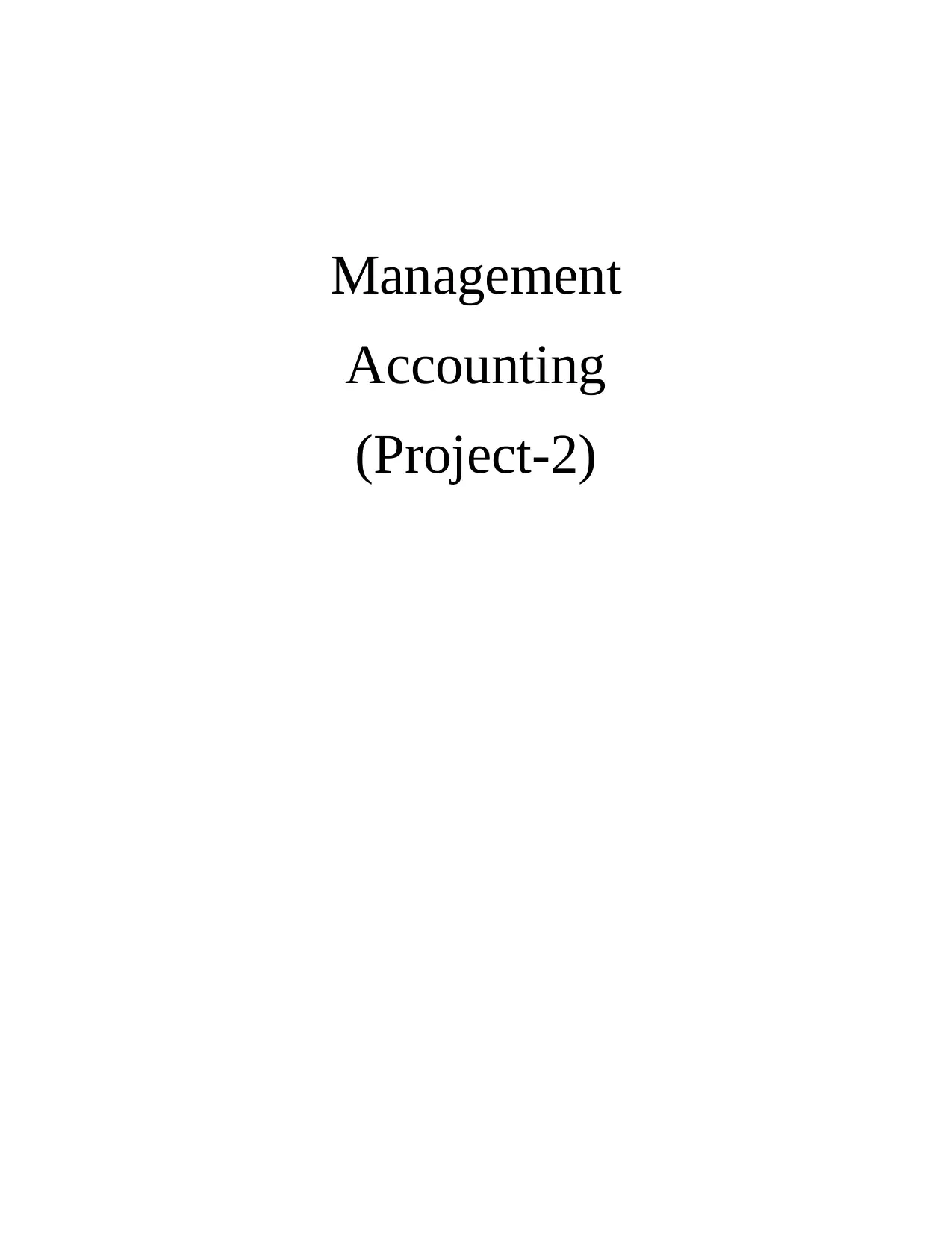
Management
Accounting
(Project-2)
Accounting
(Project-2)
Paraphrase This Document
Need a fresh take? Get an instant paraphrase of this document with our AI Paraphraser
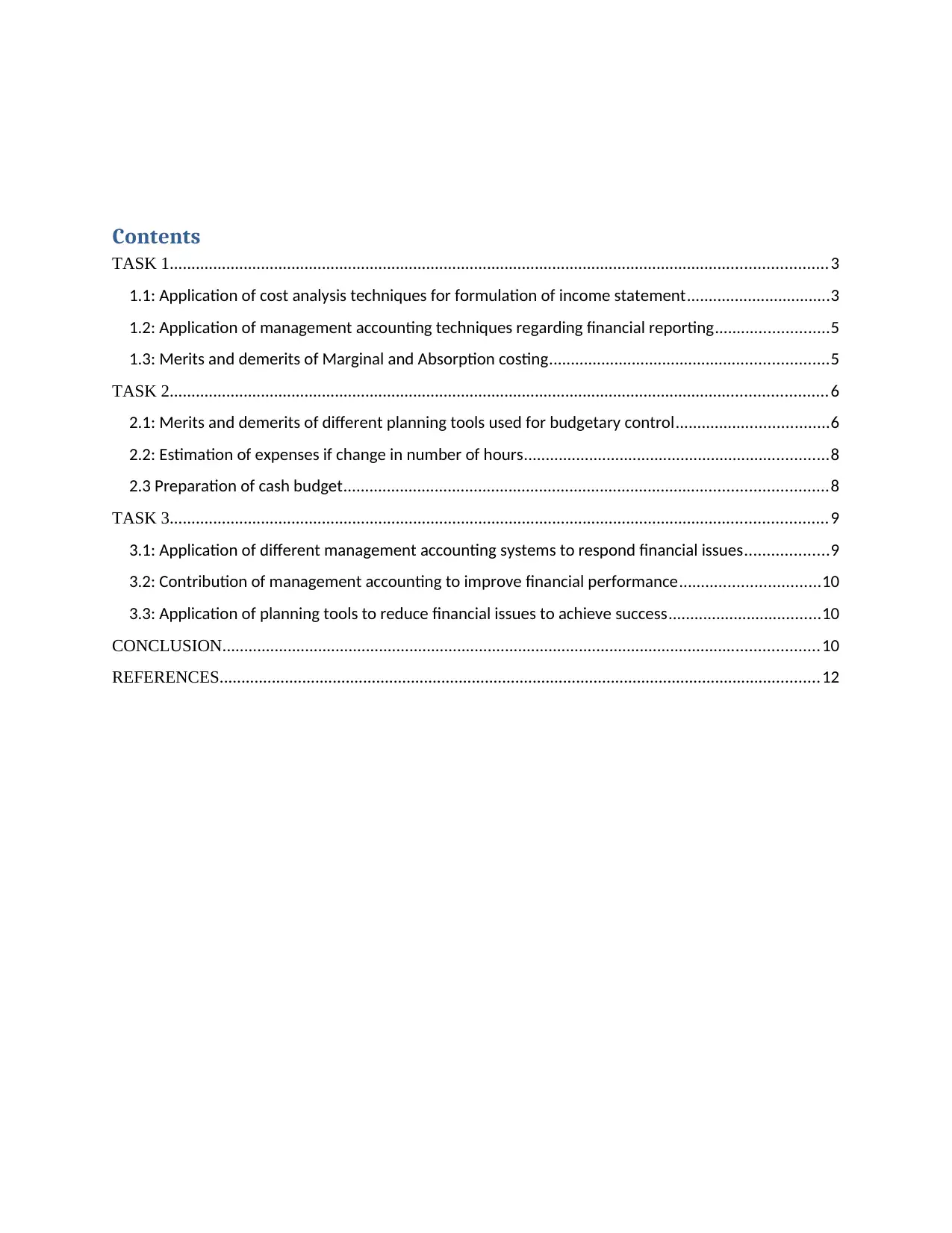
Contents
TASK 1.......................................................................................................................................................3
1.1: Application of cost analysis techniques for formulation of income statement.................................3
1.2: Application of management accounting techniques regarding financial reporting..........................5
1.3: Merits and demerits of Marginal and Absorption costing................................................................5
TASK 2.......................................................................................................................................................6
2.1: Merits and demerits of different planning tools used for budgetary control...................................6
2.2: Estimation of expenses if change in number of hours......................................................................8
2.3 Preparation of cash budget...............................................................................................................8
TASK 3.......................................................................................................................................................9
3.1: Application of different management accounting systems to respond financial issues...................9
3.2: Contribution of management accounting to improve financial performance................................10
3.3: Application of planning tools to reduce financial issues to achieve success...................................10
CONCLUSION.........................................................................................................................................10
REFERENCES..........................................................................................................................................12
TASK 1.......................................................................................................................................................3
1.1: Application of cost analysis techniques for formulation of income statement.................................3
1.2: Application of management accounting techniques regarding financial reporting..........................5
1.3: Merits and demerits of Marginal and Absorption costing................................................................5
TASK 2.......................................................................................................................................................6
2.1: Merits and demerits of different planning tools used for budgetary control...................................6
2.2: Estimation of expenses if change in number of hours......................................................................8
2.3 Preparation of cash budget...............................................................................................................8
TASK 3.......................................................................................................................................................9
3.1: Application of different management accounting systems to respond financial issues...................9
3.2: Contribution of management accounting to improve financial performance................................10
3.3: Application of planning tools to reduce financial issues to achieve success...................................10
CONCLUSION.........................................................................................................................................10
REFERENCES..........................................................................................................................................12
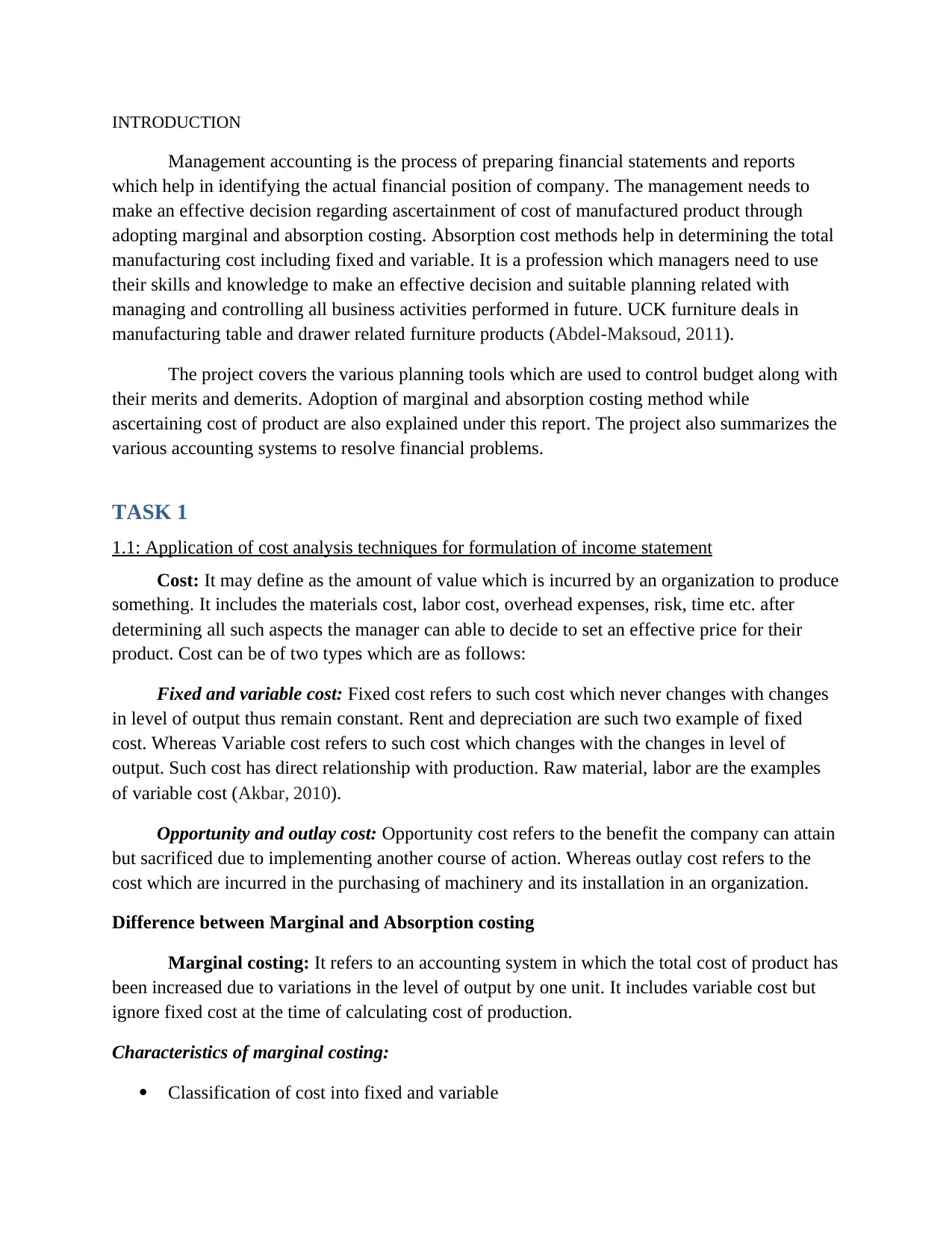
INTRODUCTION
Management accounting is the process of preparing financial statements and reports
which help in identifying the actual financial position of company. The management needs to
make an effective decision regarding ascertainment of cost of manufactured product through
adopting marginal and absorption costing. Absorption cost methods help in determining the total
manufacturing cost including fixed and variable. It is a profession which managers need to use
their skills and knowledge to make an effective decision and suitable planning related with
managing and controlling all business activities performed in future. UCK furniture deals in
manufacturing table and drawer related furniture products (Abdel-Maksoud, 2011).
The project covers the various planning tools which are used to control budget along with
their merits and demerits. Adoption of marginal and absorption costing method while
ascertaining cost of product are also explained under this report. The project also summarizes the
various accounting systems to resolve financial problems.
TASK 1
1.1: Application of cost analysis techniques for formulation of income statement
Cost: It may define as the amount of value which is incurred by an organization to produce
something. It includes the materials cost, labor cost, overhead expenses, risk, time etc. after
determining all such aspects the manager can able to decide to set an effective price for their
product. Cost can be of two types which are as follows:
Fixed and variable cost: Fixed cost refers to such cost which never changes with changes
in level of output thus remain constant. Rent and depreciation are such two example of fixed
cost. Whereas Variable cost refers to such cost which changes with the changes in level of
output. Such cost has direct relationship with production. Raw material, labor are the examples
of variable cost (Akbar, 2010).
Opportunity and outlay cost: Opportunity cost refers to the benefit the company can attain
but sacrificed due to implementing another course of action. Whereas outlay cost refers to the
cost which are incurred in the purchasing of machinery and its installation in an organization.
Difference between Marginal and Absorption costing
Marginal costing: It refers to an accounting system in which the total cost of product has
been increased due to variations in the level of output by one unit. It includes variable cost but
ignore fixed cost at the time of calculating cost of production.
Characteristics of marginal costing:
Classification of cost into fixed and variable
Management accounting is the process of preparing financial statements and reports
which help in identifying the actual financial position of company. The management needs to
make an effective decision regarding ascertainment of cost of manufactured product through
adopting marginal and absorption costing. Absorption cost methods help in determining the total
manufacturing cost including fixed and variable. It is a profession which managers need to use
their skills and knowledge to make an effective decision and suitable planning related with
managing and controlling all business activities performed in future. UCK furniture deals in
manufacturing table and drawer related furniture products (Abdel-Maksoud, 2011).
The project covers the various planning tools which are used to control budget along with
their merits and demerits. Adoption of marginal and absorption costing method while
ascertaining cost of product are also explained under this report. The project also summarizes the
various accounting systems to resolve financial problems.
TASK 1
1.1: Application of cost analysis techniques for formulation of income statement
Cost: It may define as the amount of value which is incurred by an organization to produce
something. It includes the materials cost, labor cost, overhead expenses, risk, time etc. after
determining all such aspects the manager can able to decide to set an effective price for their
product. Cost can be of two types which are as follows:
Fixed and variable cost: Fixed cost refers to such cost which never changes with changes
in level of output thus remain constant. Rent and depreciation are such two example of fixed
cost. Whereas Variable cost refers to such cost which changes with the changes in level of
output. Such cost has direct relationship with production. Raw material, labor are the examples
of variable cost (Akbar, 2010).
Opportunity and outlay cost: Opportunity cost refers to the benefit the company can attain
but sacrificed due to implementing another course of action. Whereas outlay cost refers to the
cost which are incurred in the purchasing of machinery and its installation in an organization.
Difference between Marginal and Absorption costing
Marginal costing: It refers to an accounting system in which the total cost of product has
been increased due to variations in the level of output by one unit. It includes variable cost but
ignore fixed cost at the time of calculating cost of production.
Characteristics of marginal costing:
Classification of cost into fixed and variable
⊘ This is a preview!⊘
Do you want full access?
Subscribe today to unlock all pages.

Trusted by 1+ million students worldwide
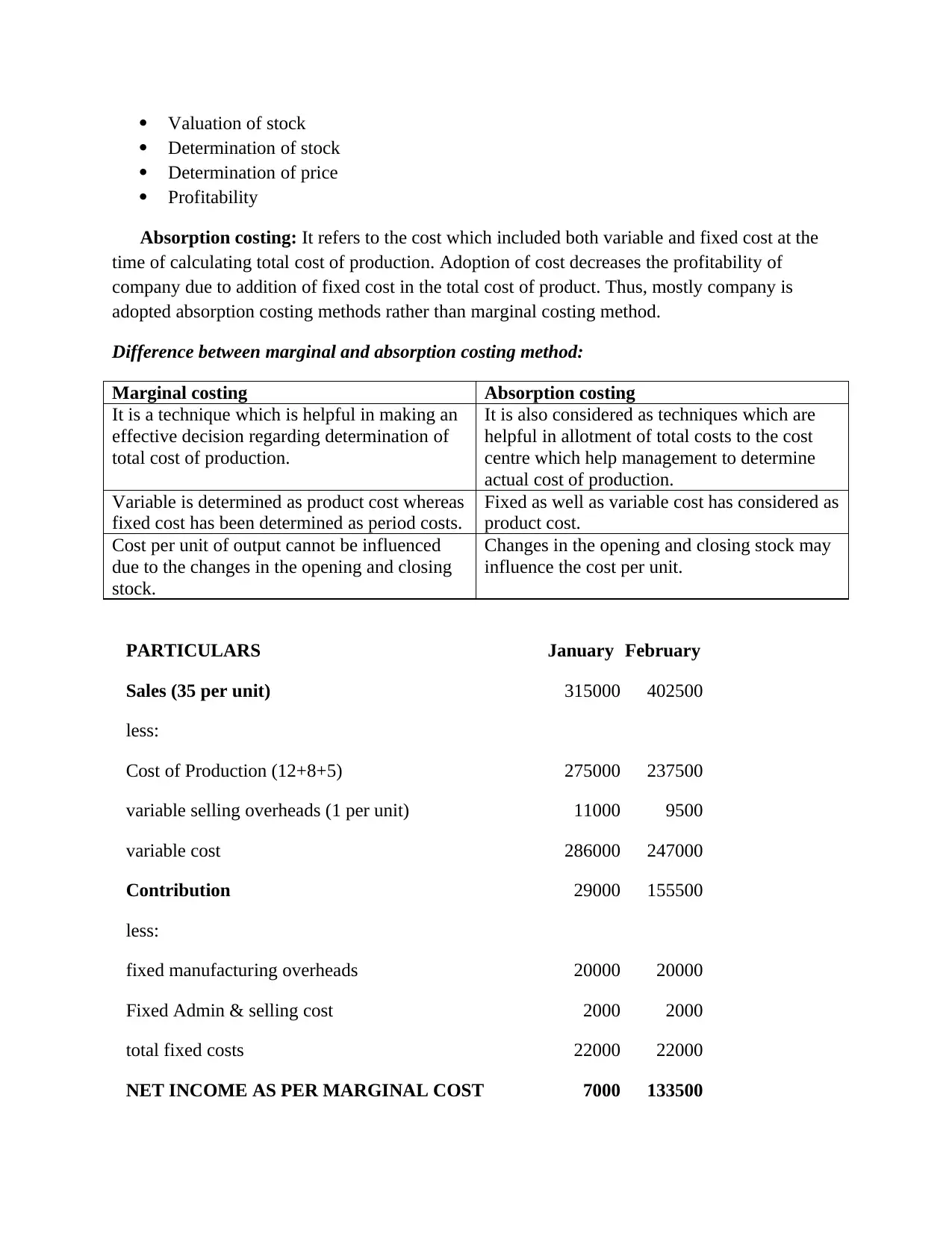
Valuation of stock
Determination of stock
Determination of price
Profitability
Absorption costing: It refers to the cost which included both variable and fixed cost at the
time of calculating total cost of production. Adoption of cost decreases the profitability of
company due to addition of fixed cost in the total cost of product. Thus, mostly company is
adopted absorption costing methods rather than marginal costing method.
Difference between marginal and absorption costing method:
Marginal costing Absorption costing
It is a technique which is helpful in making an
effective decision regarding determination of
total cost of production.
It is also considered as techniques which are
helpful in allotment of total costs to the cost
centre which help management to determine
actual cost of production.
Variable is determined as product cost whereas
fixed cost has been determined as period costs.
Fixed as well as variable cost has considered as
product cost.
Cost per unit of output cannot be influenced
due to the changes in the opening and closing
stock.
Changes in the opening and closing stock may
influence the cost per unit.
PARTICULARS January February
Sales (35 per unit) 315000 402500
less:
Cost of Production (12+8+5) 275000 237500
variable selling overheads (1 per unit) 11000 9500
variable cost 286000 247000
Contribution 29000 155500
less:
fixed manufacturing overheads 20000 20000
Fixed Admin & selling cost 2000 2000
total fixed costs 22000 22000
NET INCOME AS PER MARGINAL COST 7000 133500
Determination of stock
Determination of price
Profitability
Absorption costing: It refers to the cost which included both variable and fixed cost at the
time of calculating total cost of production. Adoption of cost decreases the profitability of
company due to addition of fixed cost in the total cost of product. Thus, mostly company is
adopted absorption costing methods rather than marginal costing method.
Difference between marginal and absorption costing method:
Marginal costing Absorption costing
It is a technique which is helpful in making an
effective decision regarding determination of
total cost of production.
It is also considered as techniques which are
helpful in allotment of total costs to the cost
centre which help management to determine
actual cost of production.
Variable is determined as product cost whereas
fixed cost has been determined as period costs.
Fixed as well as variable cost has considered as
product cost.
Cost per unit of output cannot be influenced
due to the changes in the opening and closing
stock.
Changes in the opening and closing stock may
influence the cost per unit.
PARTICULARS January February
Sales (35 per unit) 315000 402500
less:
Cost of Production (12+8+5) 275000 237500
variable selling overheads (1 per unit) 11000 9500
variable cost 286000 247000
Contribution 29000 155500
less:
fixed manufacturing overheads 20000 20000
Fixed Admin & selling cost 2000 2000
total fixed costs 22000 22000
NET INCOME AS PER MARGINAL COST 7000 133500
Paraphrase This Document
Need a fresh take? Get an instant paraphrase of this document with our AI Paraphraser
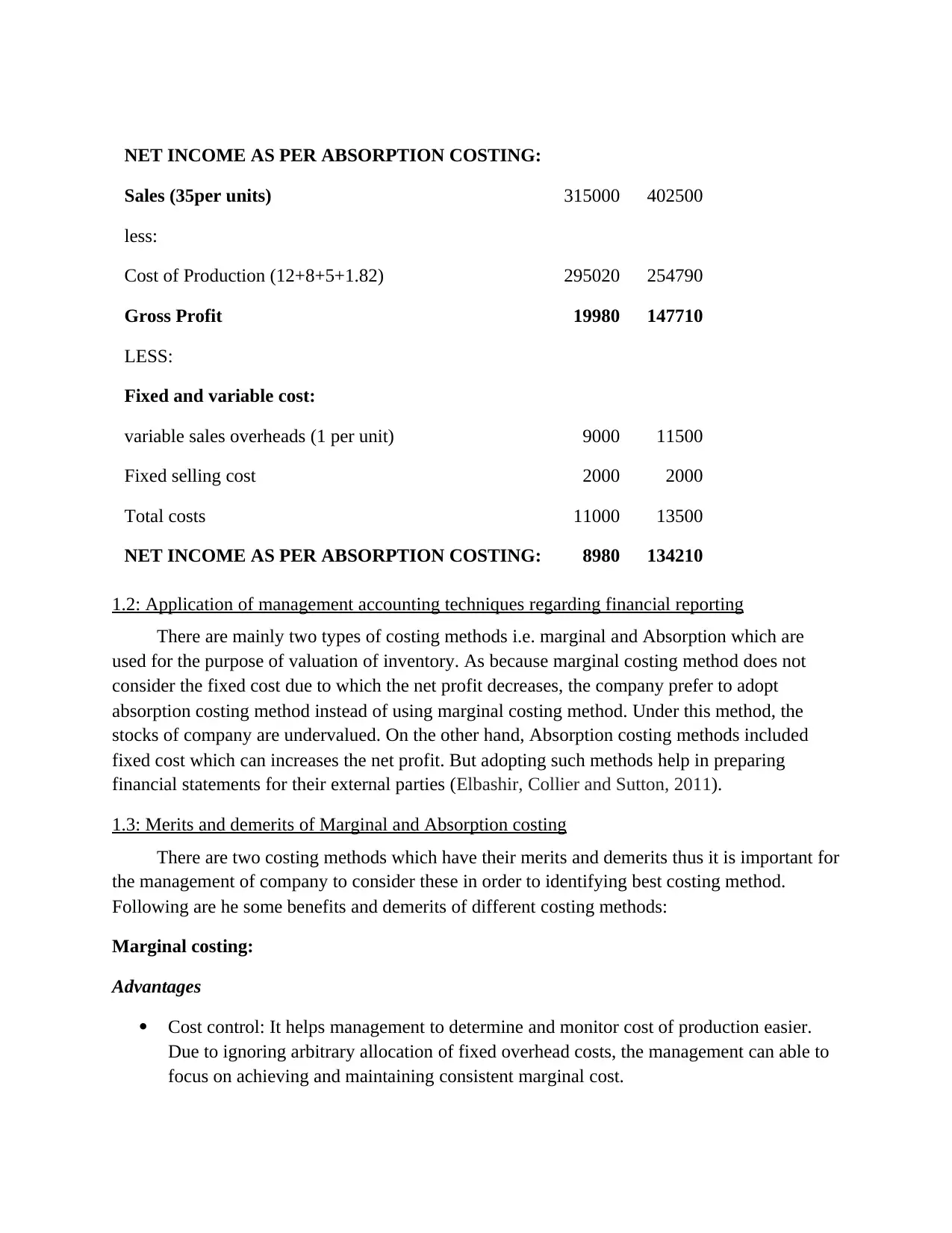
NET INCOME AS PER ABSORPTION COSTING:
Sales (35per units) 315000 402500
less:
Cost of Production (12+8+5+1.82) 295020 254790
Gross Profit 19980 147710
LESS:
Fixed and variable cost:
variable sales overheads (1 per unit) 9000 11500
Fixed selling cost 2000 2000
Total costs 11000 13500
NET INCOME AS PER ABSORPTION COSTING: 8980 134210
1.2: Application of management accounting techniques regarding financial reporting
There are mainly two types of costing methods i.e. marginal and Absorption which are
used for the purpose of valuation of inventory. As because marginal costing method does not
consider the fixed cost due to which the net profit decreases, the company prefer to adopt
absorption costing method instead of using marginal costing method. Under this method, the
stocks of company are undervalued. On the other hand, Absorption costing methods included
fixed cost which can increases the net profit. But adopting such methods help in preparing
financial statements for their external parties (Elbashir, Collier and Sutton, 2011).
1.3: Merits and demerits of Marginal and Absorption costing
There are two costing methods which have their merits and demerits thus it is important for
the management of company to consider these in order to identifying best costing method.
Following are he some benefits and demerits of different costing methods:
Marginal costing:
Advantages
Cost control: It helps management to determine and monitor cost of production easier.
Due to ignoring arbitrary allocation of fixed overhead costs, the management can able to
focus on achieving and maintaining consistent marginal cost.
Sales (35per units) 315000 402500
less:
Cost of Production (12+8+5+1.82) 295020 254790
Gross Profit 19980 147710
LESS:
Fixed and variable cost:
variable sales overheads (1 per unit) 9000 11500
Fixed selling cost 2000 2000
Total costs 11000 13500
NET INCOME AS PER ABSORPTION COSTING: 8980 134210
1.2: Application of management accounting techniques regarding financial reporting
There are mainly two types of costing methods i.e. marginal and Absorption which are
used for the purpose of valuation of inventory. As because marginal costing method does not
consider the fixed cost due to which the net profit decreases, the company prefer to adopt
absorption costing method instead of using marginal costing method. Under this method, the
stocks of company are undervalued. On the other hand, Absorption costing methods included
fixed cost which can increases the net profit. But adopting such methods help in preparing
financial statements for their external parties (Elbashir, Collier and Sutton, 2011).
1.3: Merits and demerits of Marginal and Absorption costing
There are two costing methods which have their merits and demerits thus it is important for
the management of company to consider these in order to identifying best costing method.
Following are he some benefits and demerits of different costing methods:
Marginal costing:
Advantages
Cost control: It helps management to determine and monitor cost of production easier.
Due to ignoring arbitrary allocation of fixed overhead costs, the management can able to
focus on achieving and maintaining consistent marginal cost.
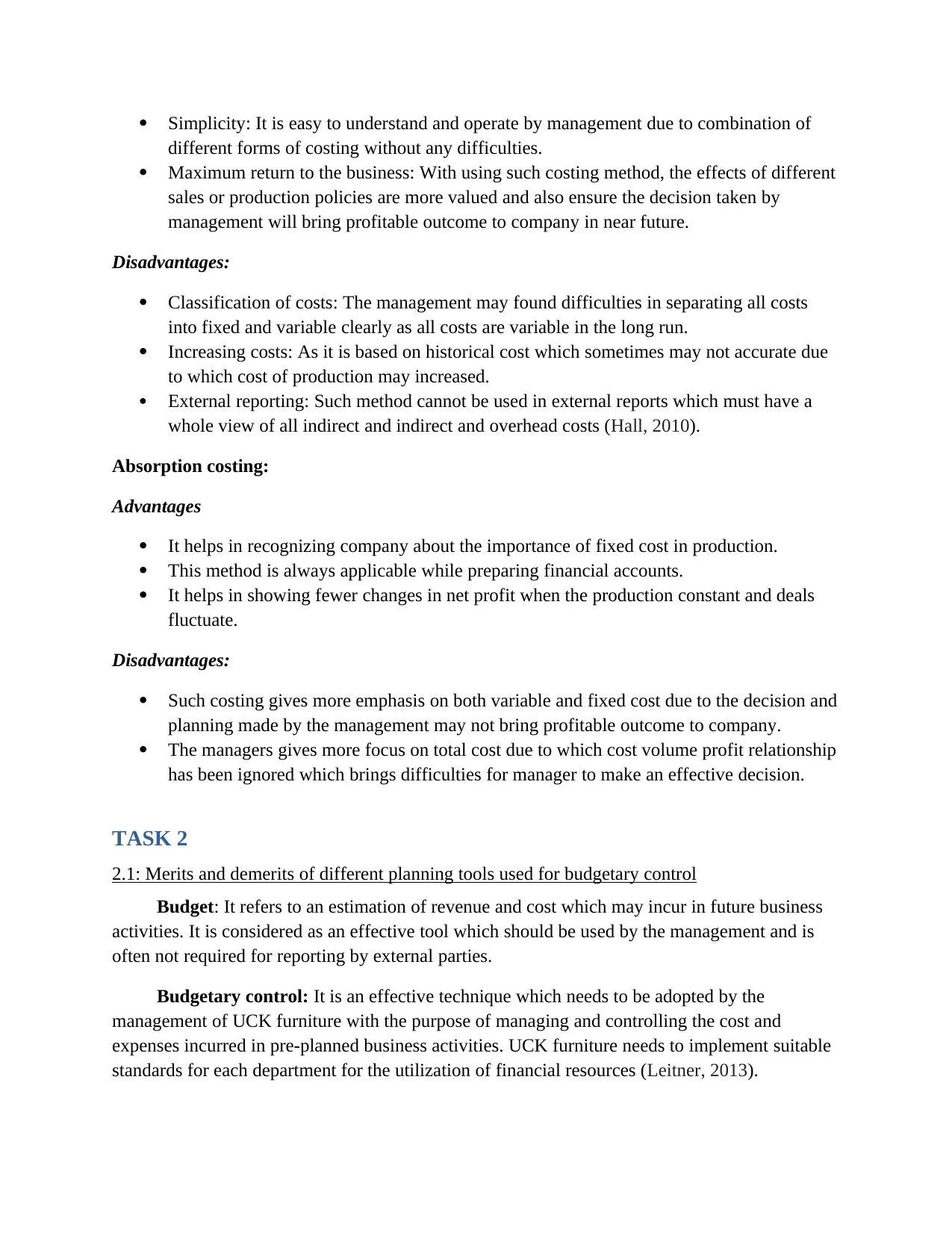
Simplicity: It is easy to understand and operate by management due to combination of
different forms of costing without any difficulties.
Maximum return to the business: With using such costing method, the effects of different
sales or production policies are more valued and also ensure the decision taken by
management will bring profitable outcome to company in near future.
Disadvantages:
Classification of costs: The management may found difficulties in separating all costs
into fixed and variable clearly as all costs are variable in the long run.
Increasing costs: As it is based on historical cost which sometimes may not accurate due
to which cost of production may increased.
External reporting: Such method cannot be used in external reports which must have a
whole view of all indirect and indirect and overhead costs (Hall, 2010).
Absorption costing:
Advantages
It helps in recognizing company about the importance of fixed cost in production.
This method is always applicable while preparing financial accounts.
It helps in showing fewer changes in net profit when the production constant and deals
fluctuate.
Disadvantages:
Such costing gives more emphasis on both variable and fixed cost due to the decision and
planning made by the management may not bring profitable outcome to company.
The managers gives more focus on total cost due to which cost volume profit relationship
has been ignored which brings difficulties for manager to make an effective decision.
TASK 2
2.1: Merits and demerits of different planning tools used for budgetary control
Budget: It refers to an estimation of revenue and cost which may incur in future business
activities. It is considered as an effective tool which should be used by the management and is
often not required for reporting by external parties.
Budgetary control: It is an effective technique which needs to be adopted by the
management of UCK furniture with the purpose of managing and controlling the cost and
expenses incurred in pre-planned business activities. UCK furniture needs to implement suitable
standards for each department for the utilization of financial resources (Leitner, 2013).
different forms of costing without any difficulties.
Maximum return to the business: With using such costing method, the effects of different
sales or production policies are more valued and also ensure the decision taken by
management will bring profitable outcome to company in near future.
Disadvantages:
Classification of costs: The management may found difficulties in separating all costs
into fixed and variable clearly as all costs are variable in the long run.
Increasing costs: As it is based on historical cost which sometimes may not accurate due
to which cost of production may increased.
External reporting: Such method cannot be used in external reports which must have a
whole view of all indirect and indirect and overhead costs (Hall, 2010).
Absorption costing:
Advantages
It helps in recognizing company about the importance of fixed cost in production.
This method is always applicable while preparing financial accounts.
It helps in showing fewer changes in net profit when the production constant and deals
fluctuate.
Disadvantages:
Such costing gives more emphasis on both variable and fixed cost due to the decision and
planning made by the management may not bring profitable outcome to company.
The managers gives more focus on total cost due to which cost volume profit relationship
has been ignored which brings difficulties for manager to make an effective decision.
TASK 2
2.1: Merits and demerits of different planning tools used for budgetary control
Budget: It refers to an estimation of revenue and cost which may incur in future business
activities. It is considered as an effective tool which should be used by the management and is
often not required for reporting by external parties.
Budgetary control: It is an effective technique which needs to be adopted by the
management of UCK furniture with the purpose of managing and controlling the cost and
expenses incurred in pre-planned business activities. UCK furniture needs to implement suitable
standards for each department for the utilization of financial resources (Leitner, 2013).
⊘ This is a preview!⊘
Do you want full access?
Subscribe today to unlock all pages.

Trusted by 1+ million students worldwide
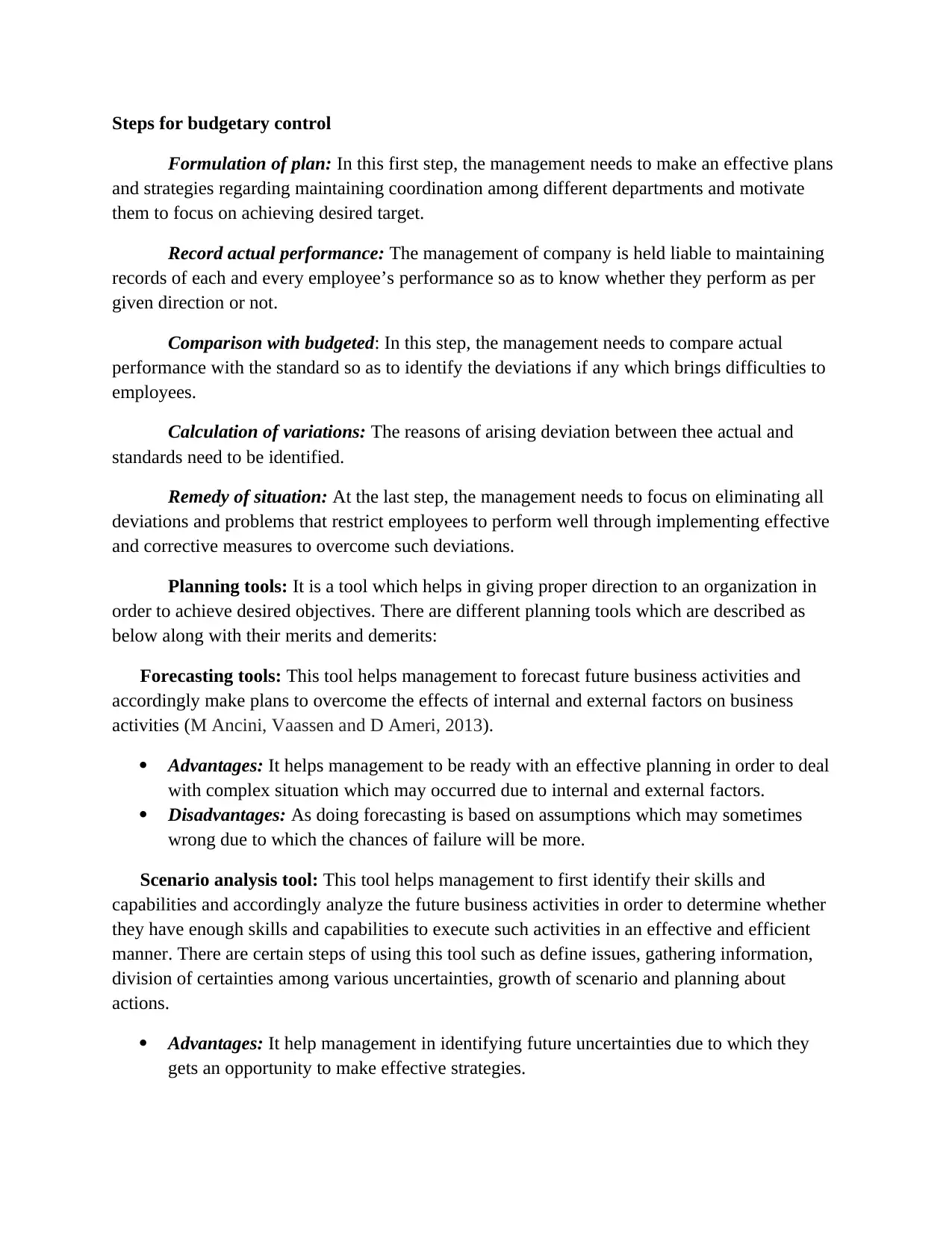
Steps for budgetary control
Formulation of plan: In this first step, the management needs to make an effective plans
and strategies regarding maintaining coordination among different departments and motivate
them to focus on achieving desired target.
Record actual performance: The management of company is held liable to maintaining
records of each and every employee’s performance so as to know whether they perform as per
given direction or not.
Comparison with budgeted: In this step, the management needs to compare actual
performance with the standard so as to identify the deviations if any which brings difficulties to
employees.
Calculation of variations: The reasons of arising deviation between thee actual and
standards need to be identified.
Remedy of situation: At the last step, the management needs to focus on eliminating all
deviations and problems that restrict employees to perform well through implementing effective
and corrective measures to overcome such deviations.
Planning tools: It is a tool which helps in giving proper direction to an organization in
order to achieve desired objectives. There are different planning tools which are described as
below along with their merits and demerits:
Forecasting tools: This tool helps management to forecast future business activities and
accordingly make plans to overcome the effects of internal and external factors on business
activities (M Ancini, Vaassen and D Ameri, 2013).
Advantages: It helps management to be ready with an effective planning in order to deal
with complex situation which may occurred due to internal and external factors.
Disadvantages: As doing forecasting is based on assumptions which may sometimes
wrong due to which the chances of failure will be more.
Scenario analysis tool: This tool helps management to first identify their skills and
capabilities and accordingly analyze the future business activities in order to determine whether
they have enough skills and capabilities to execute such activities in an effective and efficient
manner. There are certain steps of using this tool such as define issues, gathering information,
division of certainties among various uncertainties, growth of scenario and planning about
actions.
Advantages: It help management in identifying future uncertainties due to which they
gets an opportunity to make effective strategies.
Formulation of plan: In this first step, the management needs to make an effective plans
and strategies regarding maintaining coordination among different departments and motivate
them to focus on achieving desired target.
Record actual performance: The management of company is held liable to maintaining
records of each and every employee’s performance so as to know whether they perform as per
given direction or not.
Comparison with budgeted: In this step, the management needs to compare actual
performance with the standard so as to identify the deviations if any which brings difficulties to
employees.
Calculation of variations: The reasons of arising deviation between thee actual and
standards need to be identified.
Remedy of situation: At the last step, the management needs to focus on eliminating all
deviations and problems that restrict employees to perform well through implementing effective
and corrective measures to overcome such deviations.
Planning tools: It is a tool which helps in giving proper direction to an organization in
order to achieve desired objectives. There are different planning tools which are described as
below along with their merits and demerits:
Forecasting tools: This tool helps management to forecast future business activities and
accordingly make plans to overcome the effects of internal and external factors on business
activities (M Ancini, Vaassen and D Ameri, 2013).
Advantages: It helps management to be ready with an effective planning in order to deal
with complex situation which may occurred due to internal and external factors.
Disadvantages: As doing forecasting is based on assumptions which may sometimes
wrong due to which the chances of failure will be more.
Scenario analysis tool: This tool helps management to first identify their skills and
capabilities and accordingly analyze the future business activities in order to determine whether
they have enough skills and capabilities to execute such activities in an effective and efficient
manner. There are certain steps of using this tool such as define issues, gathering information,
division of certainties among various uncertainties, growth of scenario and planning about
actions.
Advantages: It help management in identifying future uncertainties due to which they
gets an opportunity to make effective strategies.
Paraphrase This Document
Need a fresh take? Get an instant paraphrase of this document with our AI Paraphraser
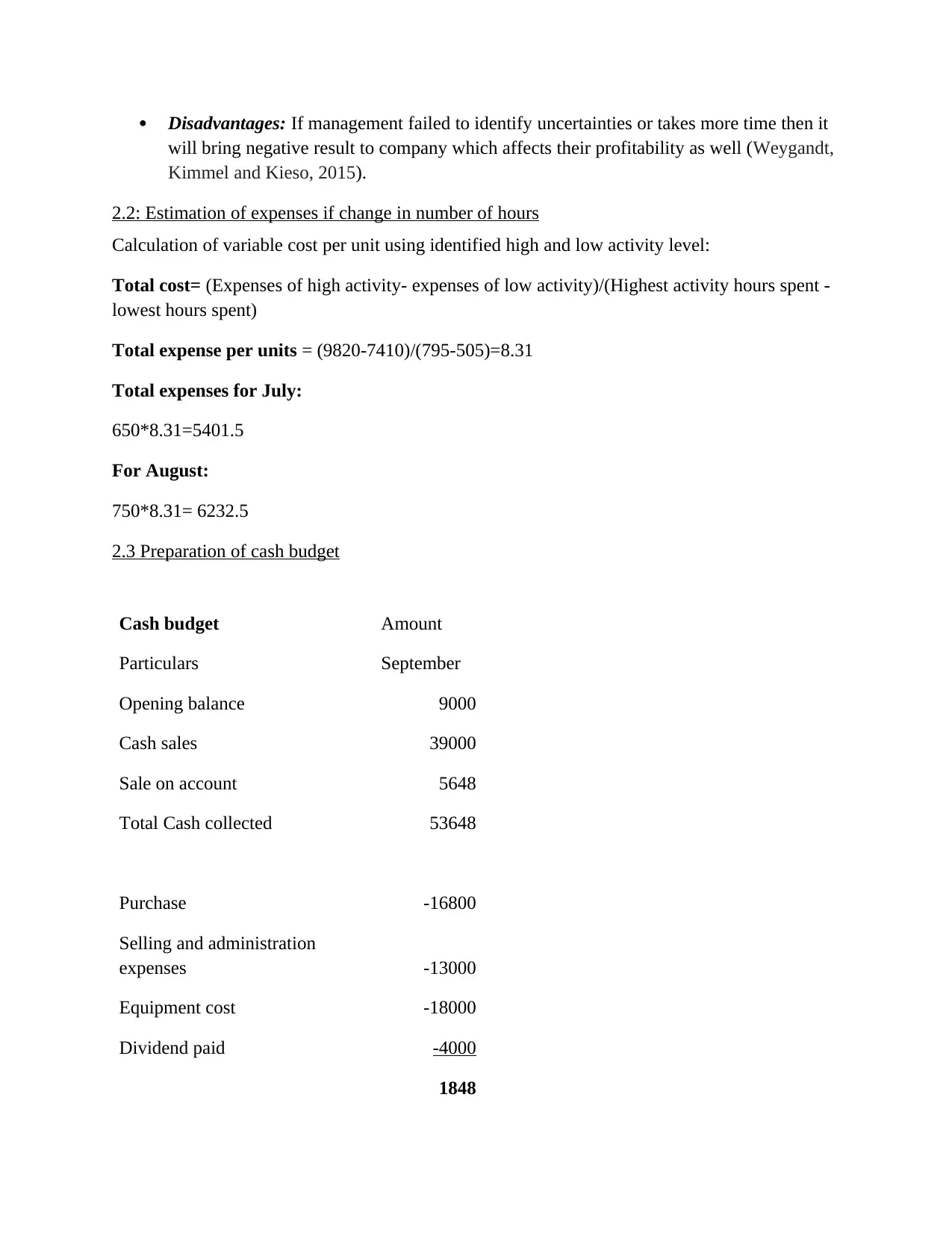
Disadvantages: If management failed to identify uncertainties or takes more time then it
will bring negative result to company which affects their profitability as well (Weygandt,
Kimmel and Kieso, 2015).
2.2: Estimation of expenses if change in number of hours
Calculation of variable cost per unit using identified high and low activity level:
Total cost= (Expenses of high activity- expenses of low activity)/(Highest activity hours spent -
lowest hours spent)
Total expense per units = (9820-7410)/(795-505)=8.31
Total expenses for July:
650*8.31=5401.5
For August:
750*8.31= 6232.5
2.3 Preparation of cash budget
Cash budget Amount
Particulars September
Opening balance 9000
Cash sales 39000
Sale on account 5648
Total Cash collected 53648
Purchase -16800
Selling and administration
expenses -13000
Equipment cost -18000
Dividend paid -4000
1848
will bring negative result to company which affects their profitability as well (Weygandt,
Kimmel and Kieso, 2015).
2.2: Estimation of expenses if change in number of hours
Calculation of variable cost per unit using identified high and low activity level:
Total cost= (Expenses of high activity- expenses of low activity)/(Highest activity hours spent -
lowest hours spent)
Total expense per units = (9820-7410)/(795-505)=8.31
Total expenses for July:
650*8.31=5401.5
For August:
750*8.31= 6232.5
2.3 Preparation of cash budget
Cash budget Amount
Particulars September
Opening balance 9000
Cash sales 39000
Sale on account 5648
Total Cash collected 53648
Purchase -16800
Selling and administration
expenses -13000
Equipment cost -18000
Dividend paid -4000
1848
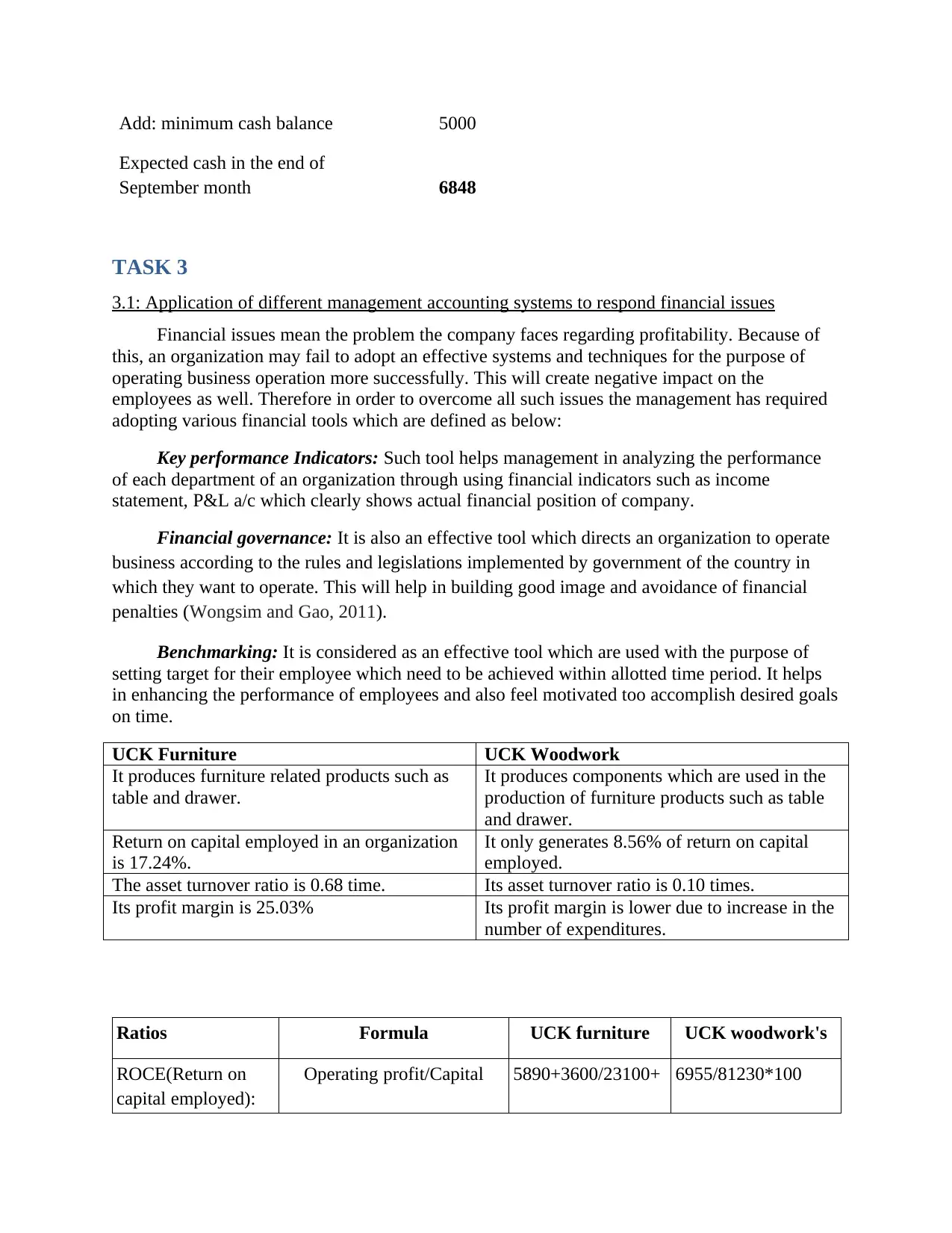
Add: minimum cash balance 5000
Expected cash in the end of
September month 6848
TASK 3
3.1: Application of different management accounting systems to respond financial issues
Financial issues mean the problem the company faces regarding profitability. Because of
this, an organization may fail to adopt an effective systems and techniques for the purpose of
operating business operation more successfully. This will create negative impact on the
employees as well. Therefore in order to overcome all such issues the management has required
adopting various financial tools which are defined as below:
Key performance Indicators: Such tool helps management in analyzing the performance
of each department of an organization through using financial indicators such as income
statement, P&L a/c which clearly shows actual financial position of company.
Financial governance: It is also an effective tool which directs an organization to operate
business according to the rules and legislations implemented by government of the country in
which they want to operate. This will help in building good image and avoidance of financial
penalties (Wongsim and Gao, 2011).
Benchmarking: It is considered as an effective tool which are used with the purpose of
setting target for their employee which need to be achieved within allotted time period. It helps
in enhancing the performance of employees and also feel motivated too accomplish desired goals
on time.
UCK Furniture UCK Woodwork
It produces furniture related products such as
table and drawer.
It produces components which are used in the
production of furniture products such as table
and drawer.
Return on capital employed in an organization
is 17.24%.
It only generates 8.56% of return on capital
employed.
The asset turnover ratio is 0.68 time. Its asset turnover ratio is 0.10 times.
Its profit margin is 25.03% Its profit margin is lower due to increase in the
number of expenditures.
Ratios Formula UCK furniture UCK woodwork's
ROCE(Return on
capital employed):
Operating profit/Capital 5890+3600/23100+ 6955/81230*100
Expected cash in the end of
September month 6848
TASK 3
3.1: Application of different management accounting systems to respond financial issues
Financial issues mean the problem the company faces regarding profitability. Because of
this, an organization may fail to adopt an effective systems and techniques for the purpose of
operating business operation more successfully. This will create negative impact on the
employees as well. Therefore in order to overcome all such issues the management has required
adopting various financial tools which are defined as below:
Key performance Indicators: Such tool helps management in analyzing the performance
of each department of an organization through using financial indicators such as income
statement, P&L a/c which clearly shows actual financial position of company.
Financial governance: It is also an effective tool which directs an organization to operate
business according to the rules and legislations implemented by government of the country in
which they want to operate. This will help in building good image and avoidance of financial
penalties (Wongsim and Gao, 2011).
Benchmarking: It is considered as an effective tool which are used with the purpose of
setting target for their employee which need to be achieved within allotted time period. It helps
in enhancing the performance of employees and also feel motivated too accomplish desired goals
on time.
UCK Furniture UCK Woodwork
It produces furniture related products such as
table and drawer.
It produces components which are used in the
production of furniture products such as table
and drawer.
Return on capital employed in an organization
is 17.24%.
It only generates 8.56% of return on capital
employed.
The asset turnover ratio is 0.68 time. Its asset turnover ratio is 0.10 times.
Its profit margin is 25.03% Its profit margin is lower due to increase in the
number of expenditures.
Ratios Formula UCK furniture UCK woodwork's
ROCE(Return on
capital employed):
Operating profit/Capital 5890+3600/23100+ 6955/81230*100
⊘ This is a preview!⊘
Do you want full access?
Subscribe today to unlock all pages.

Trusted by 1+ million students worldwide
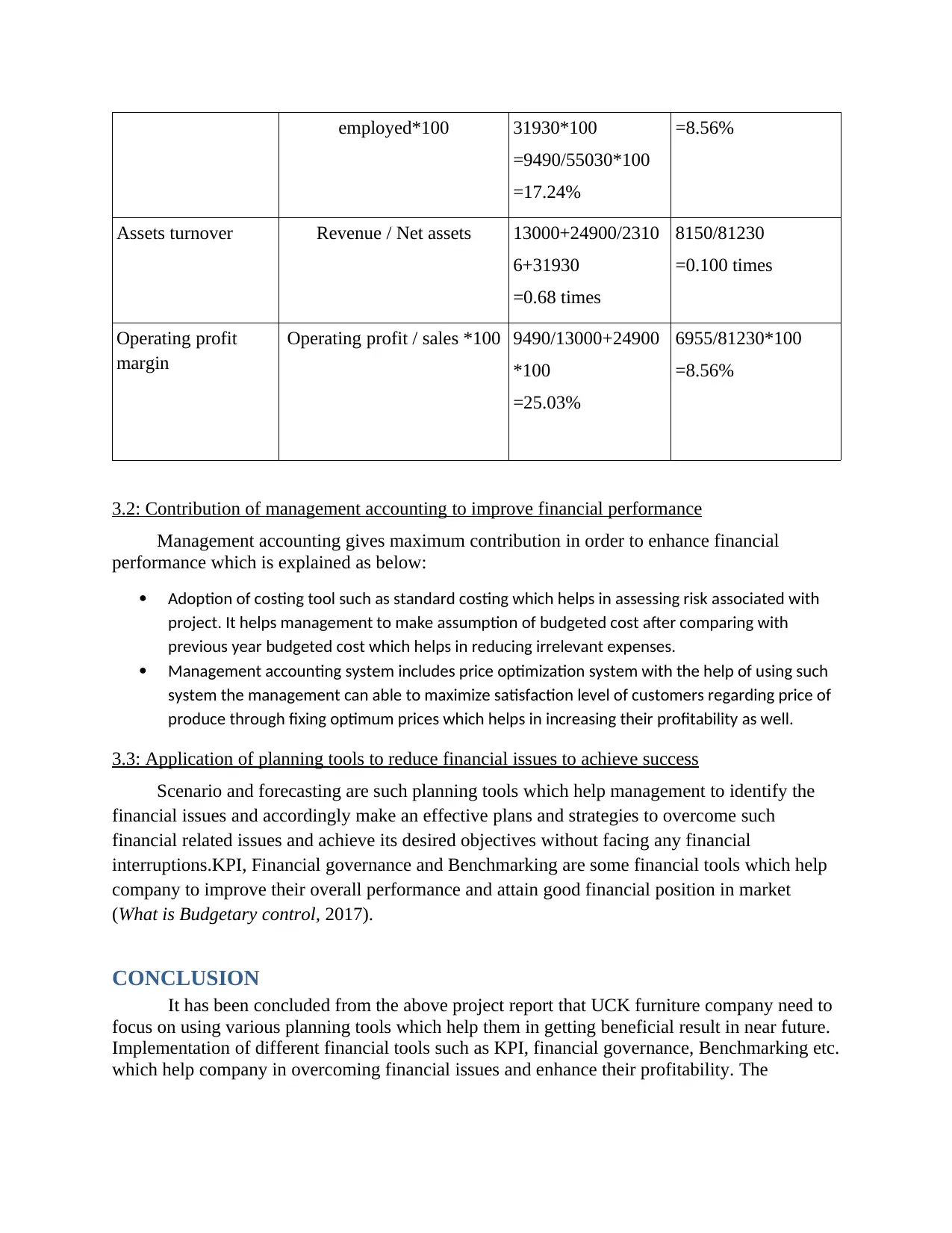
employed*100 31930*100
=9490/55030*100
=17.24%
=8.56%
Assets turnover Revenue / Net assets 13000+24900/2310
6+31930
=0.68 times
8150/81230
=0.100 times
Operating profit
margin
Operating profit / sales *100 9490/13000+24900
*100
=25.03%
6955/81230*100
=8.56%
3.2: Contribution of management accounting to improve financial performance
Management accounting gives maximum contribution in order to enhance financial
performance which is explained as below:
Adoption of costing tool such as standard costing which helps in assessing risk associated with
project. It helps management to make assumption of budgeted cost after comparing with
previous year budgeted cost which helps in reducing irrelevant expenses.
Management accounting system includes price optimization system with the help of using such
system the management can able to maximize satisfaction level of customers regarding price of
produce through fixing optimum prices which helps in increasing their profitability as well.
3.3: Application of planning tools to reduce financial issues to achieve success
Scenario and forecasting are such planning tools which help management to identify the
financial issues and accordingly make an effective plans and strategies to overcome such
financial related issues and achieve its desired objectives without facing any financial
interruptions.KPI, Financial governance and Benchmarking are some financial tools which help
company to improve their overall performance and attain good financial position in market
(What is Budgetary control, 2017).
CONCLUSION
It has been concluded from the above project report that UCK furniture company need to
focus on using various planning tools which help them in getting beneficial result in near future.
Implementation of different financial tools such as KPI, financial governance, Benchmarking etc.
which help company in overcoming financial issues and enhance their profitability. The
=9490/55030*100
=17.24%
=8.56%
Assets turnover Revenue / Net assets 13000+24900/2310
6+31930
=0.68 times
8150/81230
=0.100 times
Operating profit
margin
Operating profit / sales *100 9490/13000+24900
*100
=25.03%
6955/81230*100
=8.56%
3.2: Contribution of management accounting to improve financial performance
Management accounting gives maximum contribution in order to enhance financial
performance which is explained as below:
Adoption of costing tool such as standard costing which helps in assessing risk associated with
project. It helps management to make assumption of budgeted cost after comparing with
previous year budgeted cost which helps in reducing irrelevant expenses.
Management accounting system includes price optimization system with the help of using such
system the management can able to maximize satisfaction level of customers regarding price of
produce through fixing optimum prices which helps in increasing their profitability as well.
3.3: Application of planning tools to reduce financial issues to achieve success
Scenario and forecasting are such planning tools which help management to identify the
financial issues and accordingly make an effective plans and strategies to overcome such
financial related issues and achieve its desired objectives without facing any financial
interruptions.KPI, Financial governance and Benchmarking are some financial tools which help
company to improve their overall performance and attain good financial position in market
(What is Budgetary control, 2017).
CONCLUSION
It has been concluded from the above project report that UCK furniture company need to
focus on using various planning tools which help them in getting beneficial result in near future.
Implementation of different financial tools such as KPI, financial governance, Benchmarking etc.
which help company in overcoming financial issues and enhance their profitability. The
Paraphrase This Document
Need a fresh take? Get an instant paraphrase of this document with our AI Paraphraser
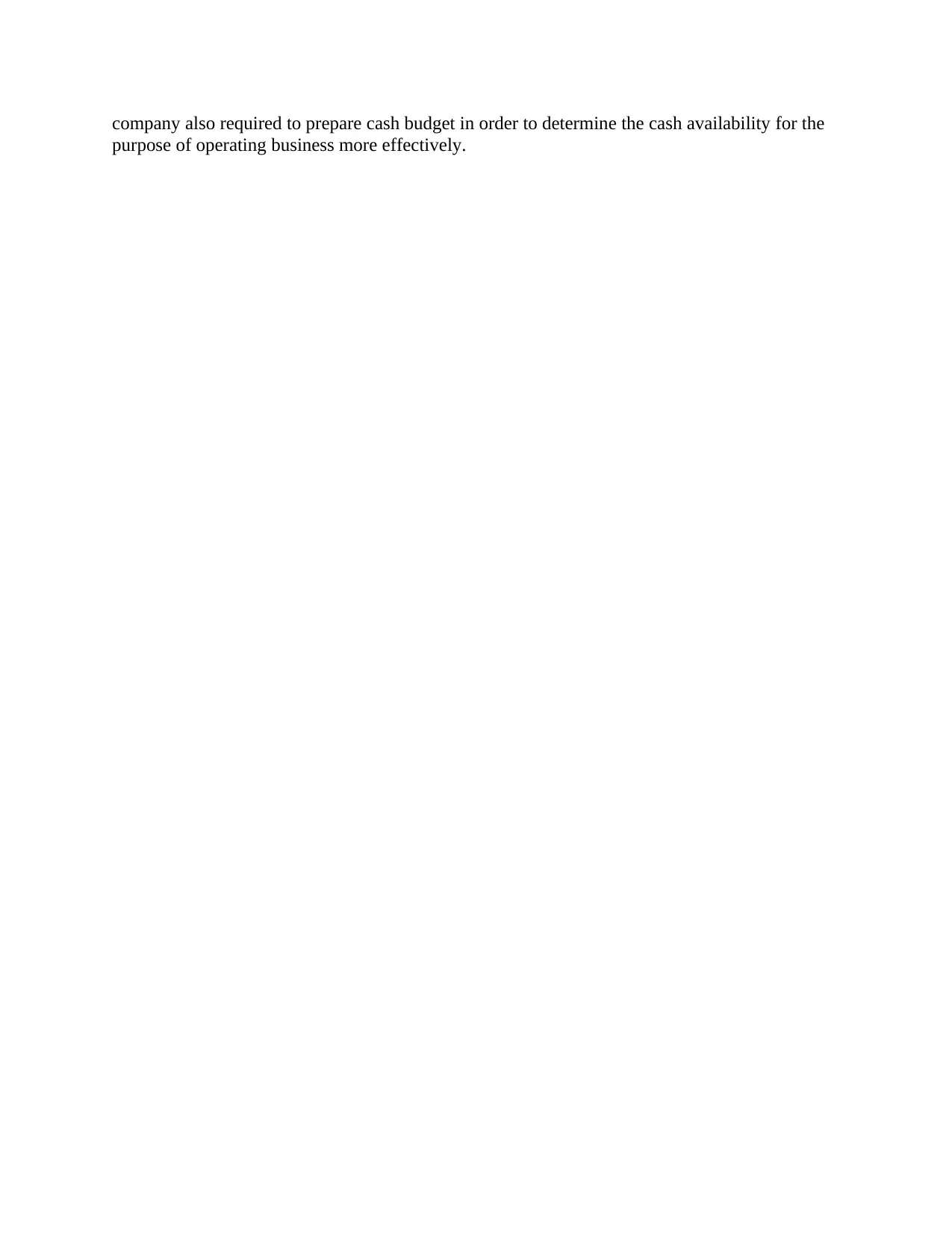
company also required to prepare cash budget in order to determine the cash availability for the
purpose of operating business more effectively.
purpose of operating business more effectively.
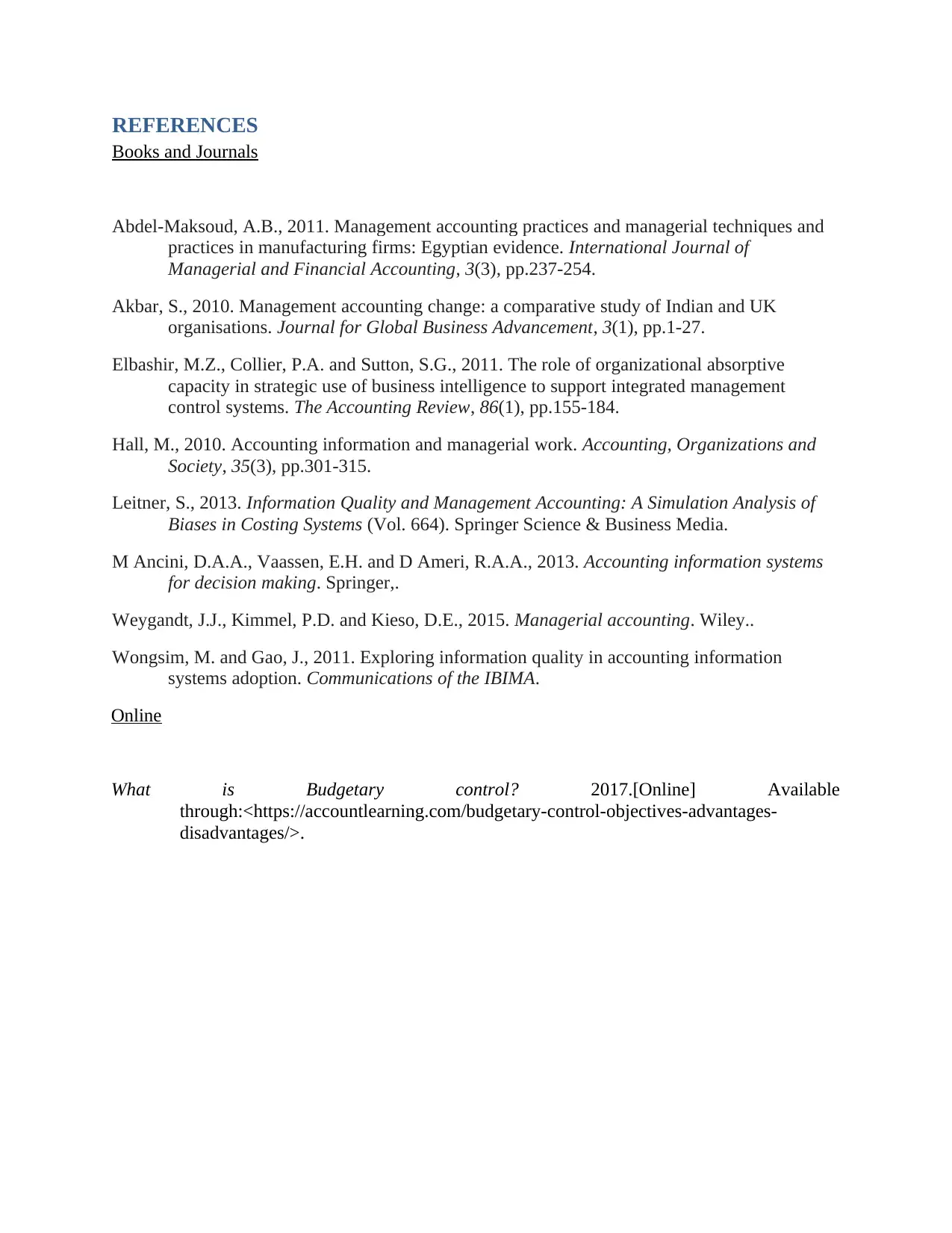
REFERENCES
Books and Journals
Abdel-Maksoud, A.B., 2011. Management accounting practices and managerial techniques and
practices in manufacturing firms: Egyptian evidence. International Journal of
Managerial and Financial Accounting, 3(3), pp.237-254.
Akbar, S., 2010. Management accounting change: a comparative study of Indian and UK
organisations. Journal for Global Business Advancement, 3(1), pp.1-27.
Elbashir, M.Z., Collier, P.A. and Sutton, S.G., 2011. The role of organizational absorptive
capacity in strategic use of business intelligence to support integrated management
control systems. The Accounting Review, 86(1), pp.155-184.
Hall, M., 2010. Accounting information and managerial work. Accounting, Organizations and
Society, 35(3), pp.301-315.
Leitner, S., 2013. Information Quality and Management Accounting: A Simulation Analysis of
Biases in Costing Systems (Vol. 664). Springer Science & Business Media.
M Ancini, D.A.A., Vaassen, E.H. and D Ameri, R.A.A., 2013. Accounting information systems
for decision making. Springer,.
Weygandt, J.J., Kimmel, P.D. and Kieso, D.E., 2015. Managerial accounting. Wiley..
Wongsim, M. and Gao, J., 2011. Exploring information quality in accounting information
systems adoption. Communications of the IBIMA.
Online
What is Budgetary control? 2017.[Online] Available
through:<https://accountlearning.com/budgetary-control-objectives-advantages-
disadvantages/>.
Books and Journals
Abdel-Maksoud, A.B., 2011. Management accounting practices and managerial techniques and
practices in manufacturing firms: Egyptian evidence. International Journal of
Managerial and Financial Accounting, 3(3), pp.237-254.
Akbar, S., 2010. Management accounting change: a comparative study of Indian and UK
organisations. Journal for Global Business Advancement, 3(1), pp.1-27.
Elbashir, M.Z., Collier, P.A. and Sutton, S.G., 2011. The role of organizational absorptive
capacity in strategic use of business intelligence to support integrated management
control systems. The Accounting Review, 86(1), pp.155-184.
Hall, M., 2010. Accounting information and managerial work. Accounting, Organizations and
Society, 35(3), pp.301-315.
Leitner, S., 2013. Information Quality and Management Accounting: A Simulation Analysis of
Biases in Costing Systems (Vol. 664). Springer Science & Business Media.
M Ancini, D.A.A., Vaassen, E.H. and D Ameri, R.A.A., 2013. Accounting information systems
for decision making. Springer,.
Weygandt, J.J., Kimmel, P.D. and Kieso, D.E., 2015. Managerial accounting. Wiley..
Wongsim, M. and Gao, J., 2011. Exploring information quality in accounting information
systems adoption. Communications of the IBIMA.
Online
What is Budgetary control? 2017.[Online] Available
through:<https://accountlearning.com/budgetary-control-objectives-advantages-
disadvantages/>.
⊘ This is a preview!⊘
Do you want full access?
Subscribe today to unlock all pages.

Trusted by 1+ million students worldwide
1 out of 12
Related Documents
Your All-in-One AI-Powered Toolkit for Academic Success.
+13062052269
info@desklib.com
Available 24*7 on WhatsApp / Email
![[object Object]](/_next/static/media/star-bottom.7253800d.svg)
Unlock your academic potential
Copyright © 2020–2025 A2Z Services. All Rights Reserved. Developed and managed by ZUCOL.





